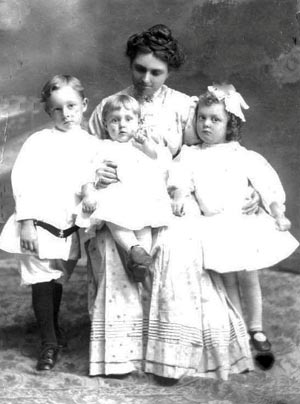Book installation, displayed at Place Des Arts Feb 7th to March 15th, 2013.
Beginnings

My daughter, on the birth of her son in 2000, asked me to record the family stories as told by my mother; stories of growing up in a small Saskatchewan town, of surviving “The Great Depression”. I have two photo albums made by my mother that span events from 1905 to 1948. I have boxes of unlabeled portraits of people, many of whom I did not know. I had to figure out who was who, guess the year the photo was taken by analyzing the background and dress and guessing the ages of the people. I researched archives, town museums and city directories to add to the tale. I Googled. These photos became the illustrations for my story.
My uncle had started a biography and died after completing only six pages. Placing them within this larger work would mean the pages would not be lost.
The Importance of Story
I am, first of all, a painter. However, I soon discovered that I had much more to say than could be said with a series of paintings. So I wrote a book. Not a typical book. It is not bound. It is boxed. Each page is designed to stand alone. I included a little bit of genealogy only to explain the relationships between the people. The STORY is more important. Vignettes of world events, lists of books people read and songs they sang add context. And no family is all good news. Telling this part was another challenge.

Several Themes Emerged
- Recycling and re-using isn’t new. It used to be the norm. Frugality meant most mothers made quilts, unravelled old sweaters to knit new ones, raised and lowered hems. The abundance of today seems to makes us less appreciative of what we have. Do we ‘treasure’ our thousands of digital photos as much as the few black and white photos taken with a little Brownie Kodak (first marketed in 1901)?
- How did people manage before pensions, before employment and health insurance? How did they survive poverty, sickness, injury?
- Advances in medicine and dentistry have transformed our life expectancy and quality of life. Today many people question the use of vaccines without knowing what life was like before these support systems existed. Don’t like to go to the dentist? Years ago it was not unusual for a bride to be given a set of false teeth as a wedding gift.
- A woman’s life is very different today. Only since 1929 women have women been deemed to be ‘persons’. Only since the 1960s have they had legal access to birth control. Since the 1980s women can qualify for a mortgage without a man co-signing for them. The invention of the refrigerator, washing machine, electricity, etc. has meant women have time to pursue a career. The evolution of women’s rights continues today. We are not there yet.
- The last 50 years have been a time of unprecedented prosperity that has left us unprepared for the next 50 years which will not be as rosy. We now face global warming and a financial crisis which may be worse than that of the 1930s.
History has lessons. But by remembering the past we increase our appreciation of today and may avoid future pitfalls by looking at past solutions.


Sample Pages
Dorothy Growing Up PDF 429 KB
Ida Bessie PDF 373 KB


